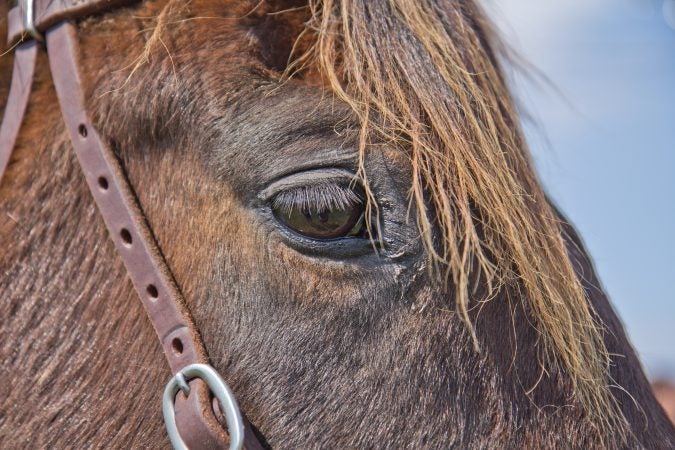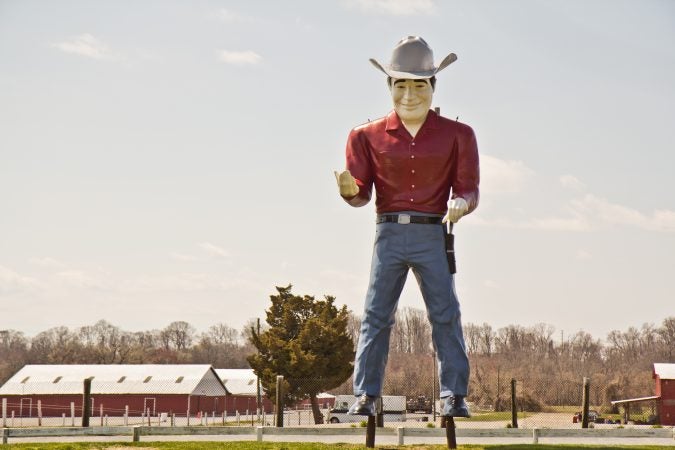No homes on this South Jersey range: 350 Cowtown acres preserved as grassland
This is the first time the U.S. Department of Agriculture has preserved grasslands in New Jersey.
Listen 1:15-

Horses Cesar and The Bay bask in the sun at the Cowtown Rodeo in Pilesgrove Township, N.J. (Kimberly Paynter/WHYY)
-

The Bay is the flag carrier during the Cowtown Rodeos. (Kimberly Paynter/WHYY)
-

The Cowtown Rodeo arena in Pilesgrove Township, N.J. (Kimberly Paynter/WHYY)
-

The Cowtown Rodeo in Pilesgrove Township, N.J. (Kimberly Paynter/WHYY)
-

Pilesgrove Township Mayor Kevin Eachus presents Cowtown owners Betsy and Grant Harris with the preservation decree. (Kimberly Paynter/WHYY)
-

The Cowtown Rodeo in Pilesgrove Township, N.J. (Kimberly Paynter/WHYY)
-

Cows in the pasture in Pilesgrove Township, N.J. (Kimberly Paynter/WHYY)
-

Carrie Lindig is the New Jersey State Conservationist with the U.S. Department of Agriculture. (Kimberly Paynter/WHYY)
-

Nate, the Harris family’s grandson, rides in pastures of the Cowtown Rodeo in Pilesgrove Township, N.J. (Kimberly Paynter/WHYY)
South Jersey’s Cowtown, which hosts the longest running weekly rodeo in the county, may bring to mind the tumbling tumbleweeds of the Old West. But a new deal to conserve its grassland means part of Cowtown’s heritage and ecology will stay put.
Partners with the New Jersey Conservation Foundation and the U.S. Department of Agriculture have worked out an arrangement that will preserve 374 acres of Cowtown with the purchase of development rights from the landowners. The $2.8 million deal includes about $2.1 million from the USDA’s Natural Resources Conservation Service, as well as a mix of public and private funds.
The Harris family will continue to own and operate the 1,700-acre ranch in Salem County, just as they have done for five generations. But the new restrictions will keep housing developers off their lawn.
“Over the years, we’ve been offered ridiculous amounts of money for land, but you can’t put a price on it,” said Grant Harris. “It is farming, ranching, whatever you want to call it — but keeping that grass healthy and productive is key to our operation.
“To do anything but take good care of it would be very shortsighted,” he said.
This is the first time the USDA has preserved grasslands in New Jersey, said Carrie Lindig, a conservationist with the Natural Resources Conservation Service.
“One of the things that makes this so significant for New Jersey is that there’s not many [parcels] left, this big, for grasslands,” said Lindig during a Wednesday ceremony to officially announce the deal. “And the soil quality here is so great, I’m surprised it never was cropped.”
Cowtown Rodeo is now a part of the USDA’s Agricultural Conservation Easement Program, which provides assistance to farmers to preserve their land and business.
The preserved grasslands are home to endangered species of birds, including the bobolink and northern harrier. Steve Eisenhauer, director of the Pennsylvania-based preservation group Natural Lands, began working with the Harris family several years ago to monitor kestrels, a species of small falcon.
“There was only one active kestrel nest around this area at that time, and now we have seven just on this farm,” said Eisenhauer.
Barn owls and upland sandpipers were once common, he said, although those species have not been spotted in years.
The Harrises recently snapped a photo of a short-eared owl.
“But it’s too soon to tell whether it’s returned,” said Eisenhauer.
WHYY is your source for fact-based, in-depth journalism and information. As a nonprofit organization, we rely on financial support from readers like you. Please give today.




